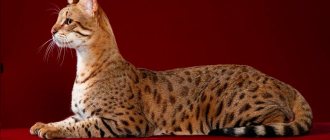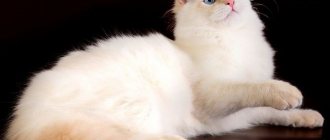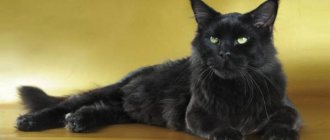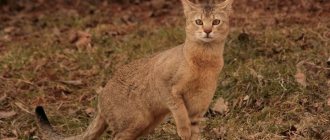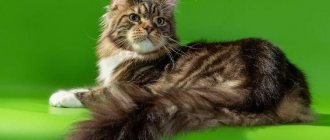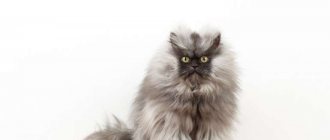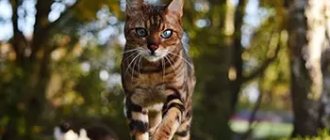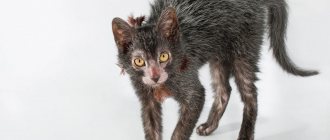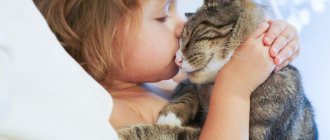Elves are unusual hairless cats with graceful movements and ears turned outward. Their exotic appearance evokes associations with the heroes of ancient fairy tales and makes you admire these cute creatures. And if you decide to get such a pet, it would be a good idea to find out how to choose the right kitten, what the standards are for this breed and the basic rules for caring for hairless animals.
Brief history of the breed
The elves were bred in the USA thanks to the dedicated work of American breeder Kristen Lead. After the death of her Sphynx pet, the woman decided to try to get similar cats that would not have a predisposition to serious hereditary pathologies.
To develop a new breed, Lead and her friend Karen Nelson decided to use Canadian Sphynxes and American Curls. The first few attempts were unsuccessful. But Lid did not lose hope and as a result received cats that resembled fairy-tale characters.
In 2006, elves were evaluated at TICA shows, and in 2007 they were given the status of an experimental breed.
Common Elf Health Problems
Because of their hairless bodies, sunburn, sensitivity to hot and cold weather, and other skin problems are potential problems for elf owners. Their delicate skin can also be easily injured, for example, by playing with a cat.
The Elf is considered a healthy cat and since she is a new breed, genetic health issues have yet to be determined. However, they may be susceptible to diseases that affect their parent breeds, such as heart and gum problems.
Interesting Facts
In the short time the breed has existed, many interesting things have been associated with it:
- Elves are very rare and expensive cats. Since nurseries specializing in breeding the breed are concentrated in the United States, the average price of such a kitten is $1,500-2,000.
- These cats received the name “elf” due to their unusual appearance and bizarrely curved ears. And because of their resemblance to hairless Canadians, they are often called elven sphinxes.
- Due to the difficulties associated with finding a partner for mating, in some countries it is not prohibited to crossbreed Canadian Sphynxes and elves. True, kittens born from such a mating will be considered mestizos and some of them will turn out to be straight-eared.
Cost of a kitten
It is still difficult to purchase a unique pet. There are very few nurseries and they are located mostly in the United States of America and Canada.
The cost of purchasing a bald kitten with elf ears in some Russian elite nurseries ranges from 60-100 thousand for a pet class. This baby is only suitable for keeping as a pet.
For breed-class individuals intended for breeding and show animals, the price starts from two to three thousand dollars. It is better to buy such pets in their historical homeland.
Babies born from crossing an Elf and a Canadian Sphynx are less expensive. Only half of the litter will be born with the breed's characteristic features - folded back ears. The most expensive cats and Elf cats are born from intrabreeding.
1111
Breed description, standards, appearance
The Elven Sphynx is a hairless, slender cat with impressive coordination, long limbs, a graceful neck and curled ear tips.
In detail - “About breeds of cats with curled ears.”
Dimensions and weight
Elves are fairly large cats with pronounced sexual dimorphism. The weight of an adult male of this breed is 7-8 kg. The weight of an elven cat varies between 5-6 kg.
Anatomical characteristics
Ideally, an elf cat should meet the following description:
- The head is wedge-shaped, with prominent cheekbones, developed whisker pads and a flat forehead. The nose is straight, with a slight dent in the bridge of the nose. The eyebrows and whiskers are broken, and in some pets they are completely absent.
- The eyes are almond-shaped, large, slightly convex. The iris can be colored green, blue or yellow. According to the standard, heterochromia is allowed in elven sphinxes.
- Elves' ears are large, wide at the base, with curved, pointed tips. The tilt angle varies between 90-180 degrees. The stable cartilage should account for at least 1/3 of the length of the ear tissue.
- The body of an elf cat is lean, muscular, with a convex belly, which gives the elf a pear-shaped body. The neck is long, with a graceful curve. The chest is round and wide.
- The limbs are strong, slender with wide oval pads. The elf's hind legs are slightly shorter than his front ones. Because of this, it seems that the cat moves with a sneaking gait.
- The elf's tail is whip-like, long, wide at the base, with a pointed tip. At rest, strongly twisted.
Color and coat type
The body of the elven sphinx is covered with hot, thick, slightly grainy skin that feels like suede. There are pronounced folds near the shoulders, between the ears and around the muzzle. Short hairs may grow on the tail, paws, outside of the ears and the bridge of the nose, the length of which should not exceed 2 mm.
The color of the Elven Sphinx can be almost any color. The most common colors in the breed are beige, light gray, black and white. According to the standard, contrasting spots are allowed on the body of the Elven Sphinx.
Possible breed defects
Disadvantages in the presence of which the elf will not receive a high expert assessment:
- high-set ears, the angle of bend of which is more than 180 or less than 90 degrees;
- profusely pubescent body;
- rounded or grooved edge of the ears;
- the body is too massive or fragile;
- insufficient number of folds on the head;
- straight profile;
- narrowed head;
- twisted or deformed tail.
Character and temperament
The elf cat is endowed with a sociable and good-natured disposition. She quickly gets used to people and tries in every possible way to demonstrate her affection. A cat of this breed loves to be the center of attention and does not tolerate loneliness well.
On a note. Elven Sphynxes are very theatrical and mannered cats, prone to demonstrative “playing for the audience.” They can be capricious and often try to attract attention to themselves.
The Elf cat loves children very much and gets along well with kids. He is very careful in his play and is patient with children's pranks.
The sociable and friendly disposition of the Elven Sphynx allows him to easily find a common language with different pets. A cat of this breed will not conflict with either its brothers or non-aggressive dogs.
Features of behavior
One of the main characteristics of elves is sociability. These are very affectionate cats, ready to endlessly spend time with their owner, rub against his legs, and follow on his heels.
Elves love children infinitely. You can safely leave them with even the smallest children - cats will play with them carefully and calmly. Elves have a flexible character, so they can find an approach and get along with any animals, even dogs.
In character, elves are very similar to their closest relatives - sphinxes. There are similarities with Siamese cats.
Elves do not tolerate loneliness, so the breed is not suitable for very busy people. And when the owner of the house, the elf does not leave him a single step.
How to choose the right kitten
Elven sphinxes are not very common outside the United States. In Russia there are only a few nurseries specializing in breeding this breed. Therefore, the search for a kitten may take a long time. To speed up the process and quickly become the owner of an exotic pet, it is better to contact foreign breeders.
Before making a final decision on purchasing an Elf cat, you need to make sure that he has documents confirming his breed and vaccinations. It also doesn’t hurt to look at the behavior of the kids and the conditions in which they are kept.
It is important that the kitten you like has a slender body covered with folded skin, a convex but not bloated belly and large ears with tips curved back.
On a note. The formation of the curve of the auricle in elven sphinxes is completed by 4-6 months. Kittens are born with straight ears, the tips of which begin to curl after a few days.
Kitten care
Weaning from the mother too early can negatively affect the character and health of little elves. Therefore, responsible breeders begin giving away kittens once they are 12 weeks old. By this age, elven sphinxes eat many foods without problems, know the litter box and know how to use a scratching post.
New owners will only have to show the pet where its toilet and bowls of water and food are located.
In order for the elf kitten to quickly get used to the changed conditions, he is given more attention and care. To avoid digestive problems due to a sudden change in diet, the hairless pet is initially fed what it ate from the breeder.
New products are introduced into the cat's menu gradually, and it should be monitored to see if they cause allergies. The elf's feeding schedule depends on the pet's age:
- 3-6 months – 4-5 times a day;
- 6-12 months – 3 times a day;
- from 12 months – 2 times a day.
On a note. Little elves are incredibly inquisitive and try to get into the most inaccessible corners of the apartment.
To protect them, wires, ornamental plants, household chemicals, and fragile and small items are kept away from kittens. And to prevent the Elven Sphinx from becoming a victim of its curiosity, you need to keep the doors of ovens, washing machines and dryers closed.
Features of buying an elf kitten
If someone likes a certain breed of cat, he will try to find a kitten. Some people are lucky and find the kittens they need quickly, but in the case of an elf this will not happen. It is unlikely that anyone will give you a representative of one of the rarest and most expensive breeds. You will have to look for such a cat yourself. There are only a few nurseries in Russia specializing specifically in elves. Of course, you can try calling breeders who deal with Sphynxes (the number can be found on the Internet). But Sphynxes are already a popular and well-known breed that is in demand, and where there is demand, there is supply.
Buying a little elf in a short time is an almost impossible desire
Usually elves are ordered from the USA (the main part of the breed is located there). However, buying a cat, as they say, from the manufacturer does not mean a low price. The most budget option for an elf can cost you 60,000 rubles. More standard kittens cost from 150,000 rubles and above. In general, the price of an elf depends on the age, gender and even color of the animal. As soon as the breed gains popularity among Russian cat breeders, the price of such animals may change. This is a lot of money, so in case of prepayment you need to ask the seller for a receipt or agreement, and also keep the receipts.
How to choose correctly
If the future owner of the elf trusts the breeder, then he will not have to think about whether the kitten meets the characteristics of the breed. But usually, the more expensive a purchase is, the more attention we pay to the details. Buying a purebred kitten is not a luxury, but acquiring a little friend who will live next to the owner for not 5 or 10 years. Therefore, you need to choose a kitten carefully and carefully.
a candidate for pets must be absolutely healthy
If you have the opportunity to examine the kitten before purchasing, make sure that everything is in order with its health:
- ears, eyes and nose should be clean;
- there should be no wounds or bite marks on the kitten’s body (small scratches may occur if there are his brothers next to the cat);
- the animal must be active and inquisitive;
- There should be no aggression on the part of the kitten.
These are external indicators of health. In addition, the elf must have a veterinary passport with vaccinations.
If you choose a pet abroad (or it is being brought from abroad), then this may be a document in English. Even if you have difficulty translating, pay attention to the photo of the animal (on the first page) and the vaccination sheet. Opposite each mark there must be a veterinarian’s signature and seal. It is important to remember that upon arrival home you should immediately contact a veterinarian to check the vaccinations already performed. If any vaccination is missing, the veterinarian can take control of it (and if necessary, carry out revaccination).
To avoid buying a kitten of another breed (for example, a sphinx) instead of an elf, pay attention to the characteristics of the breed. The body should be slender, wrinkled and without hair, the tummy should be convex and soft. Examine the ears - their tips should be turned back. A real elf can be born with straight ears (like a sphinx), but such a pet will not be allowed for exhibitions or breeding. But most often, elf cats give birth to kittens with straight ears if the father of the offspring is a Canadian Sphynx. Breeders practice this, so if there are babies with straight ears in the litter, it is better to refrain from purchasing and find another nursery. In any case, the breeder must give you the kitten's pedigree (the parents of the baby must be indicated in it).
Video: what a newborn elf kitten looks like
Is it possible to adopt an elf under three months of age?
Some people, having discovered a kitten of the desired breed in some nursery, try to pick it up right away. Sometimes this desire is influenced by low cost, and sometimes by the desire to “nurse” a small warm lump. A conscientious and responsible breeder will not give away a baby under three months of age (minimum 12 weeks). A newborn cat is vulnerable, its body is exposed to attacks from viruses and infections, so it needs immunity. Primary immunity is transmitted to cats through the cat's colostrum. If you take an ordinary outbred kitten away from its mother, it may survive, but elves take more risks in this regard.
In addition to the immune system, the cat also provides education to the kittens. It is the nurse who teaches her cubs to eat, play and go to the litter box correctly. A person cannot teach a kitten the way a cat can. In addition, if you leave a baby elf without a mother, he will experience stress, which can subsequently lead to character problems.
And another important point is vaccination. Until the cat has received its first vaccinations, responsibility for its life and health should lie with the breeder. After all, no one can guarantee that the kitten will not get sick after the move. A sudden change of place of residence can already undermine the kitten’s health, and without vaccination it is deadly. Vaccination is carried out at 3 months, so if you have already chosen an elf, but he is younger than 12 weeks, then it is better for you to wait. In order not to “miss out” on the long-awaited cat, you can book it (sometimes you need to make an advance payment for this). Many nurseries (even abroad) offer such a service as booking.
Video: elf kitten in all its glory
Care and maintenance
The body of elves is not protected by a fluffy fur coat. Therefore, the care and maintenance of these hairless cats is slightly different from the care of their ordinary counterparts. There should be no drafts in the rooms where elven sphinxes live. Also, the temperature there must be constantly maintained at 20-25 °C.
On a note. Elven sphinxes love warmth very much. To prevent hairless cats from getting burns, they need to be protected from direct sunlight.
The elf bed is set up in a quiet, cozy corner, away from heating appliances and electric fireplaces.
In order for a hairless cat to look neat, it is provided with proper hygienic care:
- Since representatives of the breed do not have eyelashes, their eyes are wiped daily with a cotton swab dipped in chamomile infusion or boiled water.
- The Elf cat's ears are regularly inspected for any unusual discharge. And the accumulated dirt is carefully removed with cotton pads moistened with a special lotion.
- The claws of the elven sphinx, as they grow, are extremely carefully shortened with a claw cutter so as not to injure living tissue.
- The cat's teeth are cleaned with a non-foaming toothpaste or a special brush 2 times a month.
- The skin of the elven sphinx is wiped daily with a piece of clean, soft, damp cloth. Particular attention is paid to folds in which keratinized particles and dust accumulate. Twice a month the cat is given bathing procedures. Bathe the elf in warm water using special shampoos for hairless breeds.
Bengal cat
0
The history of Bengal cats begins in the USA in 1961. Genetic biologist Jean Mill crossed an Asian leopard cat with a domestic leopard cat and got, if you will, a small domestic leopard. The fur of these cats is dense, short and soft (feels like expensive fur to the touch). But the character of the representatives of the breed is tough (no surprise, considering the leopards in the “pedigree”). A kitten can cost $4,000.
Feeding the cat
Elven sphinxes are big eaters. Due to their accelerated metabolism, their diet should be enriched with calories, proteins, carbohydrates and fiber.
When feeding dry food, Elf cats are given high-quality premium or super-premium products, without any questionable additives. The following brands are best suited for representatives of the breed:
- Royal Canin;
- Acana;
- Monge;
- Gemon.
With natural feeding, the diet of the Elven Sphynx should consist of 70-80% lean fresh meat. Also, a cat of this breed is given:
- eggs;
- boiled vegetables;
- porridge with water;
- offal;
- lean sea fish;
- dairy products.
Elves are forbidden to give bones, fatty meat, sausage, smoked meats, pickles, sweets and baked goods. You also need to make sure that fresh milk and any leftovers from the owner’s table do not get into the cat’s bowl.
Education and physical activity
The Elf cat breed is distinguished by high intelligence and cleanliness. These hairless pets easily learn the rules of behavior in the house and quickly get used to the tray and scratching post.
True, elven sphinxes are very vindictive and do not forgive insults. Therefore, it is necessary to raise a pet of this breed without rudeness or the use of physical force.
As children, Elf cats are very energetic and playful. And although the activity of pets decreases slightly with age, this does not mean that they will refuse to run after a ball or a laser pointer. Therefore, elven sphinxes should have several interactive toys and a corner with multi-level shelves.
Health and care
There is no detailed data on the health, predisposition to diseases and hereditary diseases among elves yet due to the fact that the breed is very young. Due to their lack of fur, they are prone to colds and infections. Therefore, it is advisable to exclude drafts.
Caring for elves should be regular. In addition to monthly washing, you need to clean your ears all the time. Between baths, you can wipe your pet's skin with a damp cloth. If the elf has small patches of fur, then the cat needs regular haircuts. If you don't do this, acne will appear.
Vaccinations and antiparasitic treatment
To protect the elf cat from viral and infectious diseases, it is vaccinated with a complex drug that stimulates the development of stable immunity:
- to calcivirus;
- rhinotracheitis;
- panleukopenia.
The first vaccination for an elf cat is given at the age of 7-8 weeks. After 4 weeks, the pet is vaccinated against the same diseases and against rabies. Subsequently, the elf is vaccinated on schedule once a year.
To prevent the cat from becoming infected with diseases carried by parasites, it is regularly treated for worms. The elf is given anthelmintic drugs 2 times a year with mandatory repetition after 10-14 days. The dose of the medicine is selected taking into account the weight of the pet.
Breeding fairy cats
Breeding elves is not that easy. Nowadays only professional breeders are engaged in breeding these cats. As a rule, this happens in nurseries where the main breeding breed is Sphynx. Most American elf nurseries breed elves with each other, and in other countries mating an elf with a sphinx is often allowed. This may be due to the fact that 2 mature individuals with folded ears are an expensive commodity. In addition, a cat can bring from 1 to 5 kittens at a time, and no one can guarantee that all the kittens will turn out exactly as they should.
Only professional breeders can breed elves competently
Elves become sexually mature at an early age (6–7 months, sometimes earlier). It is not recommended to breed a cat during her first heat, because the cat has not yet physically grown, early birth can be complicated, and kittens can be born weak. The recommended age for mating is 1–1.5 years. Despite the fact that any cat can give birth several times a year, it is not recommended to breed elves too often (the normal frequency of births is once a year or 3 times every 2 years).
How to choose a partner
It will be difficult to find a partner among house elves, because most cats of this breed fall into caring hands already neutered. A cat that can become your cat's partner can be found in a specialized nursery (for example, where you took your cat). A mature, uncastrated and healthy elf can live in another city or even country, you must be prepared for this. Most nurseries you go to will offer a Sphynx for breeding.
currently it is very difficult to find a partner for mating an elven cat
You need to decide what you want to get from the mating. If you want to continue the family line of your pet and get beautiful mestizos or you need real elves who can have a show career in the future. Mating with a Sphynx will produce mixed breeds, which may inherit weak immunity from the manufacturer. Mating with an elf will produce strong kittens, but this process will cost you more.
If you manage to find an elf, make sure that he is a real elf. He must have a veterinary passport and a pedigree (it indicates the cat’s parents). Even if both the elf’s mom and dad are the same big-eared cats, ask about the grandparents of your future partner. Of course, there is not much choice in the world of elf breeding yet, but try to find a partner with experience for your cat. It will be a shame if you go to your groom in another state and the mating fails. If everything goes well and several sleepless nights end in pregnancy for your elf, then outstanding representatives of the breed will be born from the mating. This is especially important if you plan to sell future kittens.
If the owner of the elf does not plan to get kittens from his pet, then the animal must be castrated or sterilized. This is important because sexual abstinence results in illness (sometimes fatal) for cats.
Video: castration and sterilization of cats through the eyes of a veterinarian
At what age is it recommended to have surgery?
Spaying/neutering is recommended at 9–12 months of age. Foreign veterinary clinics have long been practicing early operations, but Russian cat breeders try not to rush. Modern veterinary medicine has made great strides forward; now such operations do not harm even very young cats. Sometimes, after castration/sterilization, stitches are not even applied, since the incision remains small, it heals quickly and does not bleed (the edges of the incision can be processed with a laser).
If you have definitely decided that your pet will not (will no longer) produce offspring, then do not delay the operation. Some owners bring their cats for surgery at an advanced age, but older cats are already weak and may have difficulty withstanding anesthesia or the postoperative period. The average age at which their four-legged friends are sterilized is 1.5–2 years. The exception is cases when there are medical indications for the operation.
How to care for your cat after surgery
During the first day after surgery, the cat should be monitored. The animal recovers from anesthesia in 6–12 hours (depending on the type of anesthesia). At this time, the cat cannot coordinate in space, but tries to listen to the body. She may want to drink or go potty, but her legs won’t obey her, and the owner can help the pet. In addition, unforeseen complications may arise; in such cases, you should immediately call the veterinarian who operated on the animal.
The most difficult thing after surgery is coming out of the state of anesthesia
You need to ensure that the cat does not lick its stitches and does not remove the post-operative blanket (if any). When my cat was sterilized, the veterinary clinic gave us a blanket (it was included in the cost of the operation). The cat slept for the first few hours after returning home. Then she walked, staggering from side to side. She either tried to walk to the kitchen or crawl to the toilet, but nothing worked. I was afraid she would bump into something and hurt herself, so I moved her litter box into the room and placed her water bowl right next to the crib.
Pros and cons of the breed
Elves, like cats of other breeds, have both advantages and disadvantages.
| pros | Minuses |
| Unusual appearance | High price |
| No shedding | Inability to tolerate low temperatures |
| High intelligence | Grudge |
Elves are affectionate and highly intelligent cats with an exotic appearance and good immunity. Thanks to their playful and good-natured disposition, representatives of the breed easily find a common language with all the inhabitants of the master’s apartment and are suitable for large families with small children.
Elf Characteristics
| Attachment level | High |
| Friendliness | High |
| Suitable for children | Yes |
| Loyalty to other pets | High |
| Exercise needs | Average |
| Playfulness | High |
| Energy level | Average |
| Learning ability | Average |
| Intelligence | High |
| Tendency to meow | Average |
| Shedding intensity | Low |
